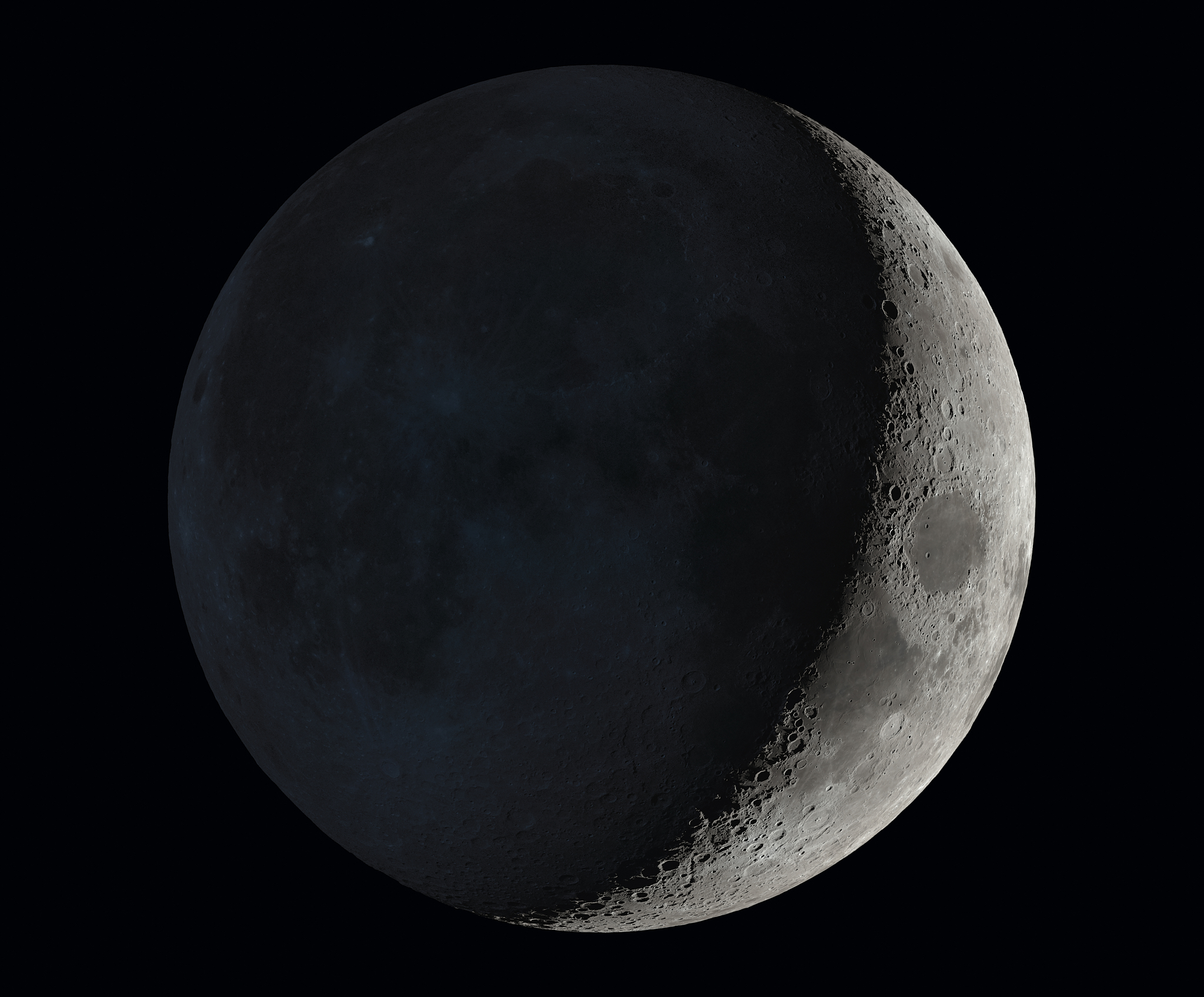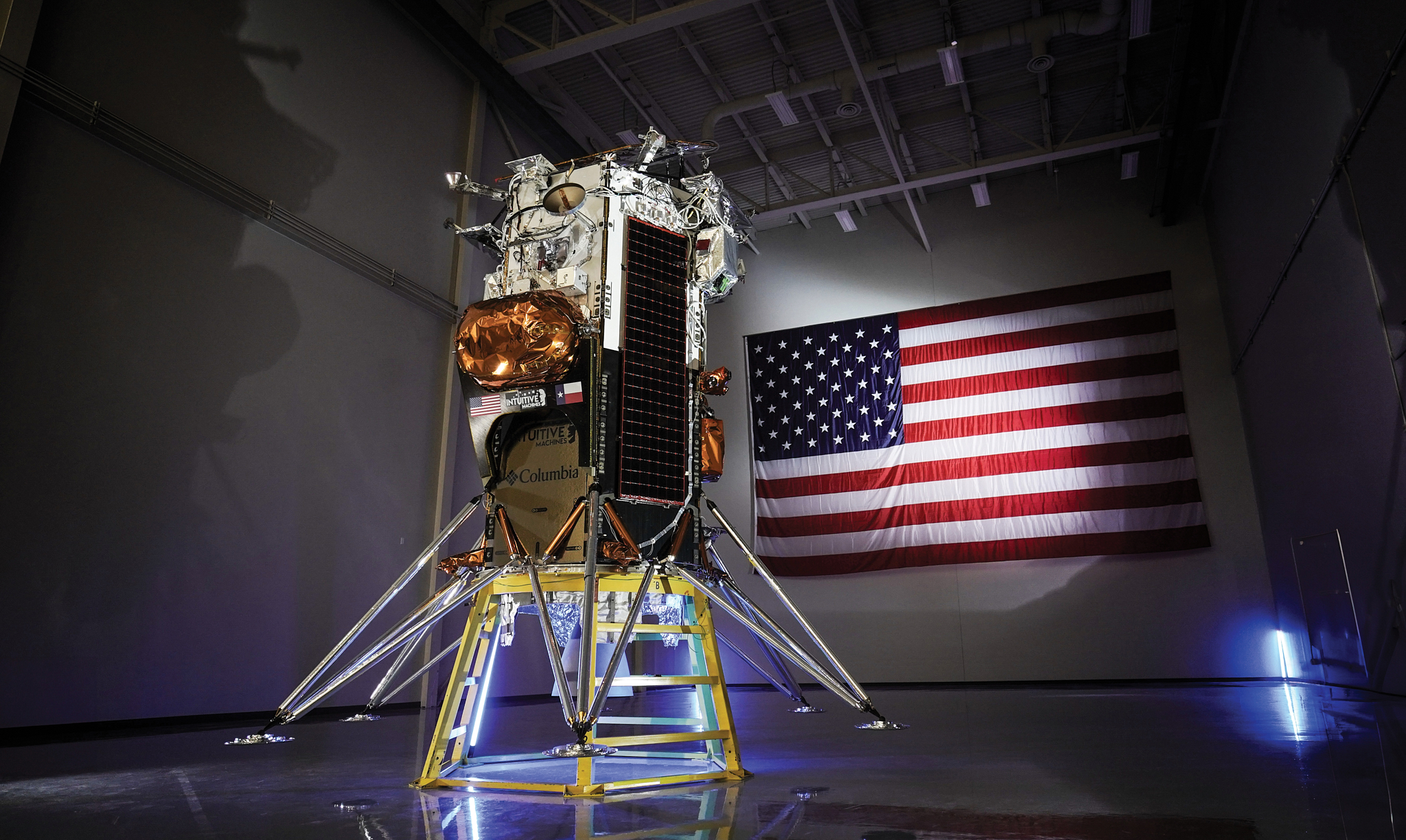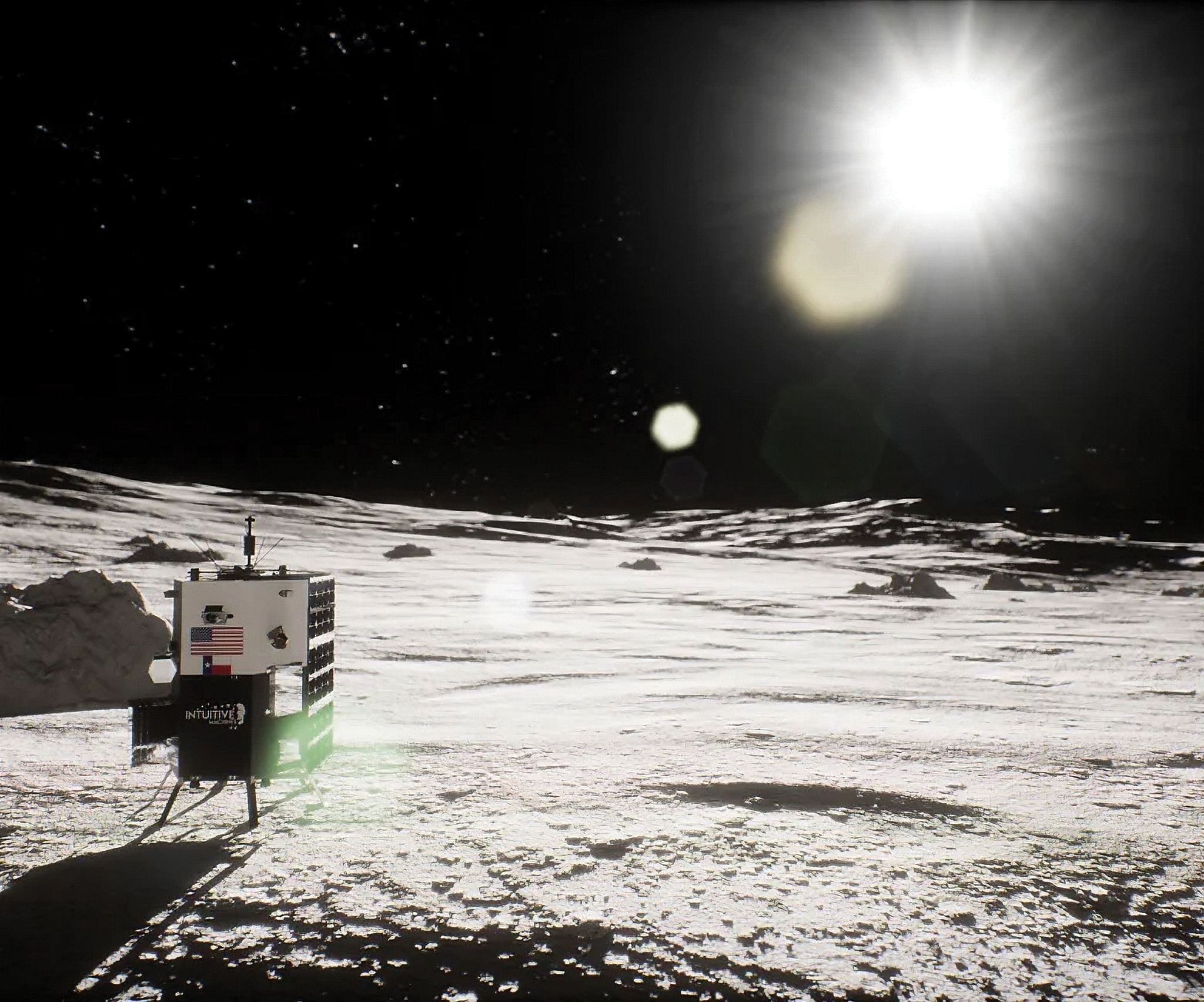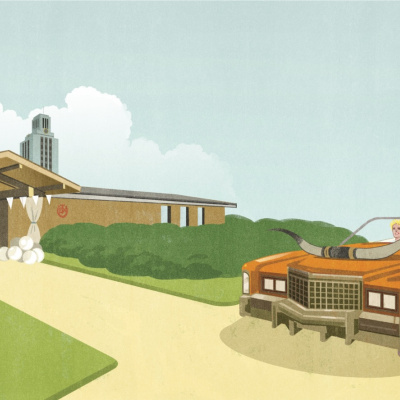Longhorns Helm Cutting-Edge Lunar Technologies

It was a mild evening in late February, and Tim Crain, BS ’95, MS ’99, PhD ’00, Life Member, was driving home from the headquarters of Intuitive Machines, a space exploration company he co-founded a decade earlier, when he glanced up and saw a full moon glowing brightly over Houston. It was a view that Crain had seen countless times before, but that evening he couldn’t keep a smile off his face. At that very moment, a spacecraft his company designed and built was orbiting Earth’s celestial neighbor. And the following day, that spacecraft achieved the first U.S. lunar landing since the legendary Apollo missions a half-century prior.
For Crain, this moonshot had been a long time coming. After graduating from UT with a PhD in aerospace engineering in 2000, he spent the first 13 years of his career at NASA, where he worked on a wide variety of projects including navigation systems for the agency’s Mars rover and an experimental lunar lander called Morpheus. Crain had joined NASA because he wanted to be a part of humanity’s next great leap to the moon and eventually to Mars. But during his time there, he witnessed the birth and death of NASA’s Constellation program, which aimed to return American astronauts to the lunar surface by 2020.

Constellation ultimately succumbed to technical hurdles, budget constraints, and shifting agency priorities, and in 2009 the program was officially shut down by the Obama administration. For Crain, it was a painful reminder of how challenging it would be to pull off such an ambitious manned mission within the confines of a large bureaucratic agency like NASA. The agency was brimming with talent and innovative ideas, but it was also subject to shifting political whims that seemed to thwart progress at every turn. He was beginning to lose faith that he would ever see a human step foot on the red planet within his lifetime when, in 2013, he was contacted by another NASA veteran Steve Altemus and the billionaire entrepreneur Kam Ghaffarian who wanted to partner with Crain on a new venture called Intuitive Machines.
The initial vision for the company was to apply engineering principles from NASA to other industries such as energy or medicine. Crain would lead a small team of elite engineers, many of them also recruited from NASA, and they would have effectively free reign to build innovative new technologies. There would be no idea too crazy or ambitious for Intuitive Machines. For Crain, it was an opportunity that was far too enticing to pass up. During his first few years at Intuitive Machines, Crain and his team invented dozens of technologies that included long-range fixed wing drones, software to evaluate oil spills, and a stroke rehabilitation robot. But Crain says the team hadn’t fallen in love with any of the technologies enough to go all in and focus the company’s efforts on them.
That all changed in late 2018 when one of Crain’s colleagues from his time at NASA suggested that the company should apply to NASA’s Commercial Lunar Payload Services (CLPS) program, which was offering contracts to private companies to deliver payloads to the lunar surface. Only a year earlier, the Trump administration had issued a policy directive instructing NASA to prioritize returning humans to the lunar surface and eventually to Mars. That program, later named Artemis, would differ from the ill-fated Constellation program insofar as many of the core technologies needed for the mission would be developed by private companies and sold to NASA to drive down costs.
In many ways, CLPS was the perfect opportunity for Intuitive Machines. Most of the NASA team had worked with Crain on the Morpheus lander—a skunkworks project to build and launch a lunar lander within 1,000 days, an unheard-of timeline at the agency—and could take what they learned to build a lunar lander of their own. But Crain knew firsthand the challenges that the team would face, and he couldn’t shake the feeling that he had heard all this before.
“When we started to really consider going all in on this lunar transportation model, I told my partner Kam, ‘Don’t mess with me. I’ve had my heart broken before on this, and if we go all in, I don’t know if I could take having my heart broken again,’” Crain says.
Still, the CLPS opportunity proved to be too enticing to resist. Intuitive Machines submitted a proposal for a lunar lander, and in May 2019 the company was one of three selected by NASA to deliver scientific payloads to the moon’s south pole. This is one of the most unforgiving lunar regions due to the presence of deep craters, steep inclines, and massive boulders. But exploring the environment is of vital importance to NASA’s plans to establish a human presence on the surface because the south pole also contains vast quantities of frozen water on the surface, which can be used for everything from growing food to manufacturing rocket fuel.

Supported by a $77 million NASA contract, Crain and the Intuitive Machines team spent the next four years working on their innovative lunar lander called Odysseus. Successfully pulling off a soft landing at the lunar south pole required them to overcome a number of daunting challenges, but one of the biggest was figuring out how to autonomously guide Odysseus to its landing spot without a human in control.
To help solve this problem, Intuitive Machines teamed up with aerospace engineering professor Maruthi Akella and his colleagues at the Cockrell School to develop a guidance and control system that would allow the lander to precisely steer the vehicle as it approached the moon for a landing. Navigation in cislunar space—the term for the expanse of space between Earth and the moon—is challenging. It’s difficult to communicate directly with the spacecraft from Earth due to transmission delays and the fact that the spacecraft passes out of sight as it orbits the moon.
Developing the guidance algorithms for the lunar lander was particularly challenging given that the spacecraft was continuously changing its orientation and depleting its fuel as it descended to the lunar surface. “The terminal descent phase to the surface is the point of no return, and the onboard guidance is what determines if you’re going to have a soft landing or crash,” Akella says. “It’s the most challenging phase of the mission because there’s no communication with ground stations on Earth so every decision needs to happen by the onboard computer.”
After a seven-day journey from Earth, Odysseus successfully landed near the lunar south pole on Feb. 23, 2024. This marked the first time a commercial company had ever successfully landed on the moon, the closest landing to the south pole in history, and the first time that a spacecraft had ever used onboard learning to autonomously pilot itself to the lunar surface. Although the spacecraft survived the landing and was able to complete its planned mission, it failed to land upright as intended.
The cause of the treacherous landing angle was ultimately traced to an unresponsive laser rangefinder, which was critical for helping the spacecraft gauge its altitude above the lunar surface during its descent. But the fact that the spacecraft was able to survive the landing at all speaks to the remarkable sophistication of the guidance algorithms that controlled its landing.
The nail-biting conclusion of Intuitive Machine’s first lunar mission dramatically underscored the need for better navigation infrastructure to enable future missions to navigate safely on and around the moon. On Earth, humans and machines are able to precisely pinpoint their location on the surface using GPS data relayed to telecommunications infrastructure from a network of dozens of orbiting satellites. This luxury isn’t available to future astronaut crews and robotic explorers that will have to navigate, guide, and pilot themselves across the barren lunar landscape with limited intervention from the ground.
In late 2023, a team of UT faculty and students led by associate professors of aerospace engineering Brandon Jones, BA, BS ’00, and Renato Zanetti, PhD ’07, was awarded a grant by NASA to devise a novel solution to the problem. The goal of the research program, known as Crater-based Navigation and Timing, is to endow spacecraft with the ability to autonomously determine their location over the moon without GPS or guidance from Earth. To make it happen, Jones and a team of undergraduates and graduate students are developing algorithms that use craters and other features on the lunar surface to precisely pinpoint a spacecraft’s location.
The first demonstrator mission, called SCOPE-1, which Jones anticipates will launch in late 2026 or early 2027, will consist of a small satellite known as a cubesat that will orbit the Earth and use the UT team’s algorithms developed to identify archipelagos captured by the satellites’ onboard cameras. The satellite’s onboard computer will then compare the shapes and other features of these archipelagos with images of the Earth’s surface that were used to train the algorithms to estimate its location in orbit. This data will then be relayed back to Earth so Jones and his team can cross reference the satellite’s estimated position with its actual position based on GPS data.
“We have to put this into low Earth orbit in a low-risk situation and demonstrate that it performs as expected before it would ever be used on Artemis,” Jones says. “It also gets the students really excited and engaged in the project because they get to work on a real satellite.”
If the SCOPE demonstrator mission is successful, Jones says that networks of small satellites could one day be sent to the moon to provide GPS-like capabilities to astronauts and rovers on the lunar surface using craters as points of reference rather than archipelagos.
But these navigation capabilities on the lunar surface will only matter if spacecraft can safely travel from the Earth to the moon. The cislunar environment is becoming increasingly crowded—and will only get more so as an increasing number of nations and private companies race to establish lunar bases and commercial operations such as mining on the surface. To help ensure safe passage in cislunar space, late last year the Air Force Office of Scientific Research provided a $4 million grant to a team of UT researchers led by Zanetti to develop novel algorithms that will improve situational awareness in the cislunar environment.
“When we’re in low Earth orbit, we have a lot of different sensor networks on the ground to make observations of these satellites and estimate where they will be in space,” says Michael Hibbard, MS ’20, now a sixth-year aerospace engineering PhD student. “But cislunar space is many times farther away than low Earth orbit, so a lot of these traditional approaches to space domain awareness really just aren’t capable of giving us that knowledge of really what’s going on up there.”
But understanding what is happening in the busy cislunar environment is only part of the challenge. Once spacecraft have a good sense of what is happening around them, they need to be able to navigate through it with a high degree of precision. To solve this challenge, the Air Force Office of Scientific Research provided Akella and a team of researchers from Penn State, Purdue, and Georgia Tech a $4.5 million grant to develop improved guidance and control algorithms designed to enable future spacecraft to safely and autonomously navigate through cislunar space.
The foundational work being done by UT faculty, alumni, and students on the infrastructure that will enable astronauts and robots to safely move through cislunar space will be critical to the success of the Artemis program and establishing a permanent human presence on the lunar surface in preparation for the next great leap to Mars. But there’s also a lot of work to be done to ensure that the first astronauts to arrive on the moon will be able to safely live and work on the surface.
One of the keys to sustaining life on the moon will be the ability to use local resources on the surface. Water is a particularly vital element to this plan, both for its ability to sustain crews and grow food, but also because it can provide the two critical inputs—hydrogen and oxygen—for manufacturing rocket fuel to power the spacecraft that will one day take humans to Mars. The problem is how to access it. Scientists know there is a significant amount of ice at the moon’s south pole, but almost all of it is at the bottom of steep, shadowed craters that would be far too hazardous for conventional lunar surface exploration technologies like rovers to access.
As part of its second mission to the moon, which is expected to launch by the end of 2024, Intuitive Machines will carry a small robot known as a “hopper” that is designed to explore polar craters as well as a drill that will deploy from the bottom of the lander to bore into the lunar surface. Crain compares Intuitive Machines’ hopper to NASA’s Mars helicopter, Ingenuity, which recently became the first spacecraft to ever fly on another planet. But unlike Mars, the moon doesn’t have any appreciable atmosphere, which means that conventional flying techniques aren’t going to work.

Instead, Intuitive Machines designed a robot called Micro Nova that stands about 3 feet tall and comes endowed with its own propulsion system that allows it to blast off the surface on short 20-to-30-minute hops and “fly” into and out of shadowed craters. It will be the first spacecraft of its kind ever tested on the lunar surface and will allow Intuitive Machines and NASA to gather valuable data from inside the craters at the south pole.
Like the lunar lander itself, Micro Nova requires ultra-precise guidance and navigation systems to control its journey across the lunar surface. Giving the hopper these navigation abilities is especially challenging given its small size and limited computing power. To help make it happen, Intuitive Machines tapped Akella to lead a team of UT students and faculty to build on the lessons learned from Intuitive Machine’s first lunar mission to develop the hopper’s navigation and guidance algorithms.
“The University of Texas excels at providing people that we can work with, explain our problems, the challenges we’re facing, and have them come back and provide us with some solutions that we can actually implement,” Crain says. “That relationship has been very important to us because it allowed us to move out of a formulation phase very rapidly into an implementation phase, and it’s a relationship we hope to keep going.”
CREDITS: From top, NASA; NASA/Robert Markowitz; Intuitive Machines (2)






